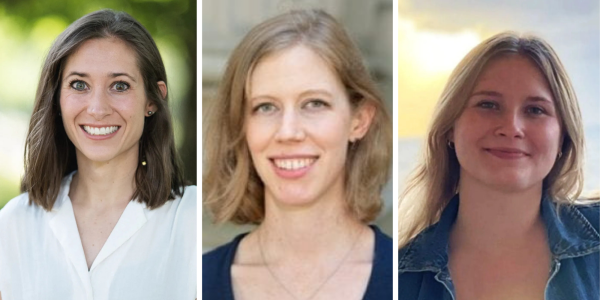Senior Ana María Núñez shares her study abroad experience digging into antiquity at the site of a famous volcanic eruption.

Last summer, Ana María Núñez went on a five-week archaeological trip to southern Italy, near Naples. She worked at the dig site Insula 14, a house in Pompeii that was covered by ash when Mount Vesuvius erupted. As a student excavator, she was assigned to a garden trench area, where she spent time learning about the workings of an archeological site.
What happened at Pompeii, and how has it been excavated over the years?

In the year 79 CE, the volcano Vesuvius erupted near the towns of Pompeii and Herculaneum. Herculaneum was covered with a pyroclastic flow and Pompeii was completely encased in ash, so the two towns were both well-preserved in very different ways.
Throughout history, people continued to live near (and on) the city of Pompeii. By the 20th century, people started doing modern archeology there. Now, two-thirds of the ash around Pompeii has been fully removed, and the town has been excavated down to the 79 CE level.
Some of the current scholarship in Pompeii focuses on digging below the 79 CE level to understand what was going on in a Roman city before the eruption, and that’s the stage of the site I worked on. The site of Insula 14 has long been thought to be a brothel because two mirrors were found there during early excavation. However, the archeologist overseeing that site, Allison Emmerson, an associate professor at Tulane University, doesn’t necessarily believe that. As student excavators, part of our job was to look for clues that could help us further understand the site's history.
What was a typical day like on the site?
It was very hot and progress was slow — but it was also rewarding. Professor Emmerson’s site is known for its digital workflow, and I was involved in that process along with digging. Photography is a hobby of mine, so I helped with the digital preservation of the site through photos. One team did photogrammetry, the process of photographing objects from every angle and feeding the images into software resulting in a 3D model from 2D images. I worked on photographing active progress on the site, as well as photographing any finds for the digital archive. Every time we broke ground on the site, it was 3D-modeled. I also helped run social media for the project.
Your academic interest in classics is focused on Greece rather than Rome, and on textual analysis rather than archeology. So why did you choose to do an archeological dig?

Yes, classics studies the ancient Mediterranean world — including ancient Greece and Rome — through the lenses of language, literature, history, and culture. My primary focus is Greek languages and text — my senior thesis is on the writing of Thucydides about the Peloponnesian War between Athens and Sparta — not the Roman world or material objects. But as someone who hopes to continue to study classics, I thought it was important to get to know the full extent of the field.
I loved my five weeks in this Roman city. When you’re reading a text, it’s easy to forget that these were real people who intentionally shaped the land for their own purposes. Now, when I read an academic paper about the “stratigraphic layer,” a term for an individual layer of soil based on its color and feel, I understand it in a totally different way.
What drew you to be a classicist? And what’s next for you?
I’m from Puerto Rico and I’ve always enjoyed languages; I grew up speaking English and Spanish. In high school I read “The Odyssey” and I loved English classes. I wanted to study something text-heavy and a teacher suggested classics. I took Greek my freshman year at WashU, and I've been taking classics courses ever since.
These two big civilizations are constantly overlapping with our modern world in politics, medicine, and popular culture. Classics is relevant in so many things we do, and that drives me to keep studying it. I hope to attend graduate school for classics. I’m in the middle of applying to programs now. It might not be the most lucrative field, but I’m going to keep studying it as long as possible because I love it.




